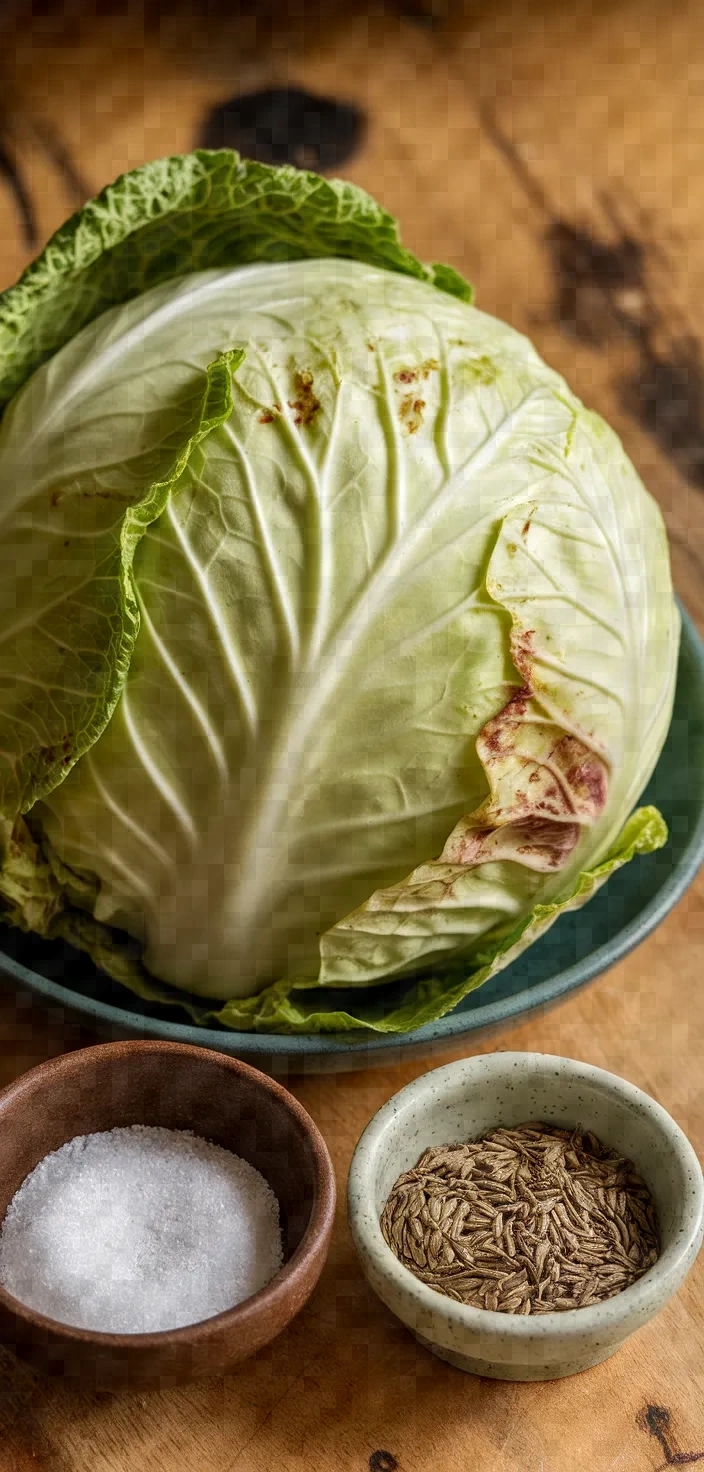I absolutely adore this homemade sauerkraut recipe because it’s both incredibly simple and deeply rewarding to watch the transformative power of fermentation at work. Plus, there’s nothing quite like that tangy crunch with a hint of caraway to take my meals to the next level while knowing it’s packed with gut-boosting probiotics!

The probiotic-rich homemade sauerkraut has a sharp, tangy flavor profile that I love. You can create a condiment that is ridiculously healthy and good for your gut with just a head of cabbage, kosher salt, and a few caraway seeds.
Some people might add more spices, but the way I see it, good nutrients and flavor—along with a sauerkraut that you can make in about five minutes, then wait a couple of weeks for it to ferment, and then wait a couple of more weeks until it tastes amazing—are enough reasons for you to try making it.
Ingredients

Cabbage, green: Stuffed with fiber, as well as vitamins C and K, which are crucial for digestion and support healthy gut microbiota.
Kosher salt: Necessary for fermentation, imparts taste, keeps cabbage crisp.
Caraway seeds: Earthy spice that is optional, adds aromatic flavor, helps with digestion.
Ingredient Quantities
- 1 medium head of green cabbage (about 3 pounds)
- 1 tablespoon kosher salt
- 1-2 teaspoons caraway seeds (optional)
Instructions
1. Take off the outer leaves of the cabbage and divide it into quarters.
2. Cut the cabbage into quarters, then cut each quarter into thin, even shreds.
3. In a big bowl, mix together the sliced cabbage and kosher salt.
4. With your hands, work the salt into the cabbage for about 5-10 minutes, until it starts to release liquid and becomes limp.
5. If you are using caraway seeds, add them and mix them thoroughly into the mixture.
6. Tightly pack the cabbage into a clean jar or crock, pressing it down firmly to release more liquid and eliminate any air pockets.
7. Make sure the cabbage is entirely under the surface of the liquid. If it tends to float, you may need to weight it down with a clean, heavy object.
8. Ensure that the cloth or lid over the jar or crock permits gas to escape.
9. Keep the sauerkraut at room temperature and out of direct sunlight for 1-4 weeks. Check and taste it regularly until it attains the level of fermentation you desire.
10. When it is ready, seal the sauerkraut with a lid and store it in the refrigerator for up to several months.
Equipment Needed
1. Cutting board
2. Chef’s knife
3. Large bowl
4. Clean jar or crock
5. Measuring spoons
6. Cloth or breathable lid
7. Clean, heavy object (optional, for weighting down cabbage)
8. Spoon or tamper (for pressing cabbage down in the jar or crock)
FAQ
- How should I prepare the cabbage for sauerkraut?Take off any tough outer leaves, divide the cabbage into quarters, and cut out the core; then slice it as thinly as possible.
- Can I use regular table salt instead of kosher salt?For its purity and consistency, kosher salt is best. But if you must, you can use table salt in lesser amounts.
- Is it necessary to add caraway seeds?Optional caraway seeds impart a particular flavor, but sauerkraut will ferment nicely without them.
- How long does the fermentation process take?Fermentation usually requires 1 to 4 weeks. How long it takes depends on the individual’s taste preference and the temperature of the room.
- How do I know when the sauerkraut is ready?When the sauerkraut tastes tangy and has a pleasant sour flavor to your liking, it is ready.
- How should I store finished sauerkraut?Once your sauerkraut has achieved the fermentation level you desire, keep it in the refrigerator to slow fermentation and maintain flavor.
- Can I use red cabbage instead of green cabbage?Certainly, red cabbage can be utilized; however, it will yield a divergent taste and hue.
Substitutions and Variations
You can use red cabbage for a different color and taste if green cabbage is not available.
Do not use iodized table salt when fermenting because it may inhibit fermentation. You can use sea salt or pickling salt, but kosher salt tends to be a better choice for fermenting. For fermenting vegetables, you will need about 1/4 cup of salt for every 5 to 6 pounds of vegetables.
You could substitute cumin seeds for caraway seeds to get a similar aromatic flavor, if you don’t have caraway seeds.
Pro Tips
1. Use high-quality, fresh cabbage: Choosing the freshest cabbage will ensure better texture and flavor in your sauerkraut. Look for firm, heavy heads with crisp, vibrant leaves.
2. Proper fermentation environment: Maintain a consistent room temperature of around 65-75°F (18-24°C) for optimal fermentation. Fluctuating temperatures can affect the process and the final taste.
3. Be patient with the massaging: When massaging the salt into the cabbage, take your time to ensure the cabbage releases enough liquid to create its own brine. This step is crucial for the fermentation process.
4. Use a weight and cover: Keep the cabbage submerged under the brine by using a weight like a smaller jar filled with water. Additionally, cover the top with a clean cloth to protect it from dust while allowing gases to escape.
5. Experiment with flavors: If you like, try adding other spices or ingredients such as juniper berries, apple slices, or ginger to personalize your sauerkraut and enhance its flavor profile.

How To Cook Sauerkraut Recipe
My favorite How To Cook Sauerkraut Recipe
Equipment Needed:
1. Cutting board
2. Chef’s knife
3. Large bowl
4. Clean jar or crock
5. Measuring spoons
6. Cloth or breathable lid
7. Clean, heavy object (optional, for weighting down cabbage)
8. Spoon or tamper (for pressing cabbage down in the jar or crock)
Ingredients:
- 1 medium head of green cabbage (about 3 pounds)
- 1 tablespoon kosher salt
- 1-2 teaspoons caraway seeds (optional)
Instructions:
1. Take off the outer leaves of the cabbage and divide it into quarters.
2. Cut the cabbage into quarters, then cut each quarter into thin, even shreds.
3. In a big bowl, mix together the sliced cabbage and kosher salt.
4. With your hands, work the salt into the cabbage for about 5-10 minutes, until it starts to release liquid and becomes limp.
5. If you are using caraway seeds, add them and mix them thoroughly into the mixture.
6. Tightly pack the cabbage into a clean jar or crock, pressing it down firmly to release more liquid and eliminate any air pockets.
7. Make sure the cabbage is entirely under the surface of the liquid. If it tends to float, you may need to weight it down with a clean, heavy object.
8. Ensure that the cloth or lid over the jar or crock permits gas to escape.
9. Keep the sauerkraut at room temperature and out of direct sunlight for 1-4 weeks. Check and taste it regularly until it attains the level of fermentation you desire.
10. When it is ready, seal the sauerkraut with a lid and store it in the refrigerator for up to several months.
